St. Pete’s Wicked Ways
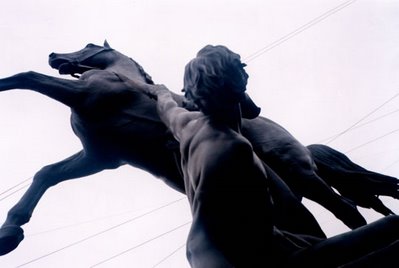
I recently stumbled across an article on Vanity Fair.com written by one of their many editors—Victoria Mather. The article was about St. Petersburg, Russia, and read like jacket copy for a romance novel. Vanity Fair employs some of the most talented English-language writers on the planet, but somehow their travel dispatches are always a little limp. None of them dig deeply, get to the heart of matters. They are content to describe peaceful scenes lit by lamplight and filmed through star filters. In the foreground you see couples kissing chastely under a bridge as boats drift by. Perhaps VF publishes these sorts of stories because their readers are well-heeled boomers whose yen for adventure passed with their last gallstone, or perhaps it’s because the brand is owned by Condé-Nast, travel publishers extraordinaire. But still, for a magazine with VF’s investigative reputation, this travelogue style reporting is a little disappointing.
Russians don’t kiss under bridges much—those places are the domain of black marketeers who sell western goods at a tenth the price charged in the United States. Russians love their nation, but the weakness of their tattered old ruble means their chances of getting ahead are enhanced by a mattressful of dollars or euros. It’s technically illegal to accept them for retail services, so subterfuge is needed. When I was there several years ago I hadn’t yet exchanged my currency when dinnertime came around, so I looked specifically for the magic Visa symbol in restaurant windows. At the restaurant I chose the credit machine was broken—which none of the staffers bothered to mention until after the meal. Clearly this was deliberate.
The waiter faked embarrassment about the mix-up, and then asked, “Would you happen to have dollars, sir?”
Well, it just so happened I did. I reached for them.
“Not here, sir—in the back.”
We retired to a dim corner at the rear of the restaurant. After he twice showed me with a calculator that he was not cheating me, I paid the ruble-tabulated bill with dollars, thus helping stiff the central government of the tax they would collect if there existed an electronic record of the transaction. I felt like I was in a spy movie. And then I realized—in a sense, I was. Being in St. Petersburg was like playing a bit part in a John Frankenheimer film—the role of Oblivious Diner #3, who appears screen right and exits screen left without ever noticing the protagonist and villain at centerscreen swapping a cash-filled briefcase for a microchip.
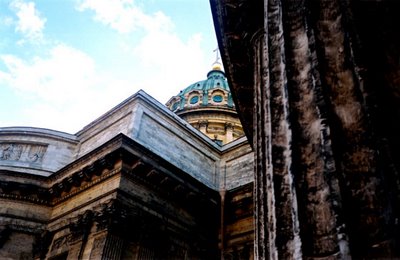
When capitalism flooded through the cracked Iron Curtain, the Russians who fared best were those ready to embrace true Western vice and rob their brethren blind. An entire gangster elite rose out of Soviet ashes. Pyramid schemes, American porn, and high-grade Amsterdam ecstasy abounded. Beautiful prostitutes paraded openly along the Nevsky Prospect. Electronic piracy made instant millionaires—they drove Jeep Grand Cherokees and Mercedes coupes, and bought boxes at Petrovsky Stadium to cheer on Zenit FC. They were above the law—in the busiest sector of town someone brought to my notice black-on-black Russian Mafia cars parked on the sidewalks, as a meter maid ambled past and instead issued tickets to vehicles sitting at expired meters.
An underground railroad funneled contraband art and artifacts to wealthy Western collectors. Rumors abounded that the State Hermitage Museum (pictured below), one of the largest art repositories in the world, was being looted. This likely had been going on for decades, but the arrival of capitalism made art theft much more lucrative. The museum was supposedly bleeding masterpieces—seemed all you had to do was walk past and a priceless artifact would drop into your arms. Officials were tight-lipped about this for years, but when thieves skated with 221 precious items in July 2006, museum director Mikhail Piotrovsky had no choice but to acknowledge the theft. He said it certainly had been an inside job. Piotrovsky commented: “The presumption of innocence and the atmosphere of absolute trust in curators that has reigned in the museum in the past will have to change. The new economic reality has affected how people think, and money has begun to play a greater role.”
One of the missing artifacts was recovered in August when police received an anonymous call pointing them toward a garbage bin outside a building on Ulitsa Ryleyeva. They arrived to find an icon worth $200,000 sitting in the trash. In art circles the rumor mill revved to overdrive. The Hermitage, which houses more than three million pieces, was simply unable to keep a close watch on the entire horde. Thieves got the message and more heists followed. September 2006—five more works go poof, including a crystal flagon adorned with a crown holding 300 rubies and 24 pearls. December 2006—a female custodian foils yet another theft by grappling with a man who had broken a glass case with his elbow and tried to escape with a valuable ladle. The whole situation seemed right out of the Pink Panther. To be complete the story needed only David Niven climbing the Hermitage using suction cups.
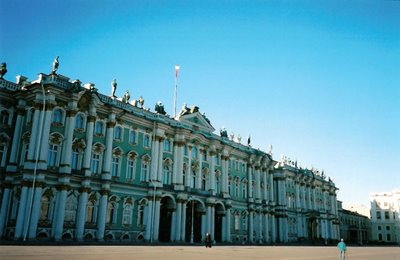
Even the Case of the Irradiated Sushi—now playing on the international stage—connects to St. Petersburg. Italian newspapers reported that Mario Scaramella, a security consultant who has helped Italy's parliament investigate Cold War-era Soviet espionage, met with Alexander Litvinenko that fateful day in London and revealed a hit-list containing both their names. Scaramella says he had a source who told him that the threat came from Mafia-style criminals based in St. Petersburg, possibly acting on behalf of Russian president Vladimir Putin. Scaramella’s source also allegedly implicated the same criminals in the assassination of Russian journalist Anna Politkovskaya in October. This is all pure cloak and dagger. Even the names seem lifted from the pages of a spy novel—Ian Fleming's Man with the Golden Gun was named Scaramanga. Mario Scaramella may well be the man with the golden vial. He was in the best position to season Litvinenko's sushi with polonium-210, and himself had only a glass of water as poor Alexander noshed a meal that would soon send him the way of Marie Curie.
 Litvinenko’s death was certainly bizarre, and as such, also quintessentially Russian. Consider: Leo Tolstoy died at a remote rail junction, having renounced his literature and wealth, and adopting the life of a wandering ascetic. Mystery continues to cloud Stalin’s death—stroke, or murder? Leon Trotsky was pickaxed—not icepicked—rather an exotic departure. And speaking of death exotica, Grigory Rapsutin (left) was first poisoned, then shot multiple times, then dumped into the frozen Neva River through a hole in the ice, where he later drowned, or died of exposure after climbing out downriver. Check the firsthand account of one of the assassins, Stanislaus de Lazovert, as he describes the moments after Rasputin was initially shot: “The others came bounding over to him and stood over his prostrate, writhing body. It was suggested that two more shots be fired to make certain of his death, but one of those present said, ‘No, no; it is his last agony now.’ We left the room to let him die alone, and to plan for his removal and obliteration. Suddenly we heard a strange and unearthly sound behind the huge door that led into the library. The door was slowly pushed open, and there was Rasputin on his hands and knees, the bloody froth gushing from his mouth, his terrible eyes bulging from their sockets. With an amazing strength he sprang toward the door that led into the gardens, wrenched it open and (ran) out.”
Litvinenko’s death was certainly bizarre, and as such, also quintessentially Russian. Consider: Leo Tolstoy died at a remote rail junction, having renounced his literature and wealth, and adopting the life of a wandering ascetic. Mystery continues to cloud Stalin’s death—stroke, or murder? Leon Trotsky was pickaxed—not icepicked—rather an exotic departure. And speaking of death exotica, Grigory Rapsutin (left) was first poisoned, then shot multiple times, then dumped into the frozen Neva River through a hole in the ice, where he later drowned, or died of exposure after climbing out downriver. Check the firsthand account of one of the assassins, Stanislaus de Lazovert, as he describes the moments after Rasputin was initially shot: “The others came bounding over to him and stood over his prostrate, writhing body. It was suggested that two more shots be fired to make certain of his death, but one of those present said, ‘No, no; it is his last agony now.’ We left the room to let him die alone, and to plan for his removal and obliteration. Suddenly we heard a strange and unearthly sound behind the huge door that led into the library. The door was slowly pushed open, and there was Rasputin on his hands and knees, the bloody froth gushing from his mouth, his terrible eyes bulging from their sockets. With an amazing strength he sprang toward the door that led into the gardens, wrenched it open and (ran) out.”Some would say this is the sort of thing travelers don’t really want to read about their destinations, but I disagree. The trend in tourism is toward authenticity and grit. Many people prefer to climb a volcano or kayak the Amazon than be directed to and fro by nametagged tour guides: “Don’t wander back there, sir—that’s off-limits.” A little danger is attractive—like a lover with a dark side. Tales of murder and backstabbing add intrigue to St. Petersburg, a city already far too beautiful to benefit much from the
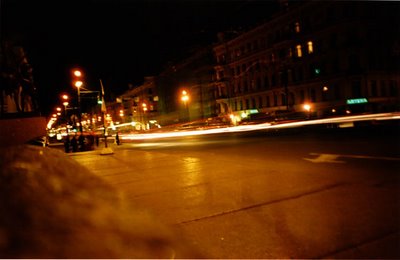 descriptive powers of bedazzled travel editors. But just for the heck of it, I’ll try my hand at travelogue right now: St. Petersburg is a metropolis of revolutionary monuments, hulking stone museums, and Venetian-style canals. The colors will surprise—the wedding cake palaces and ice cream scoop cathedrals form a Christmas cityscape beneath turbulent clouds that fume and roil in a white sky still sunlit come the stroke of midnight.
descriptive powers of bedazzled travel editors. But just for the heck of it, I’ll try my hand at travelogue right now: St. Petersburg is a metropolis of revolutionary monuments, hulking stone museums, and Venetian-style canals. The colors will surprise—the wedding cake palaces and ice cream scoop cathedrals form a Christmas cityscape beneath turbulent clouds that fume and roil in a white sky still sunlit come the stroke of midnight.Yeah, that was fun, but I like the grit better.
Labels: russia, st. petersburg, travel





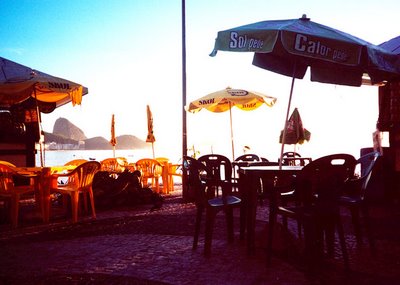

















0 Comments:
Post a Comment
<< Home